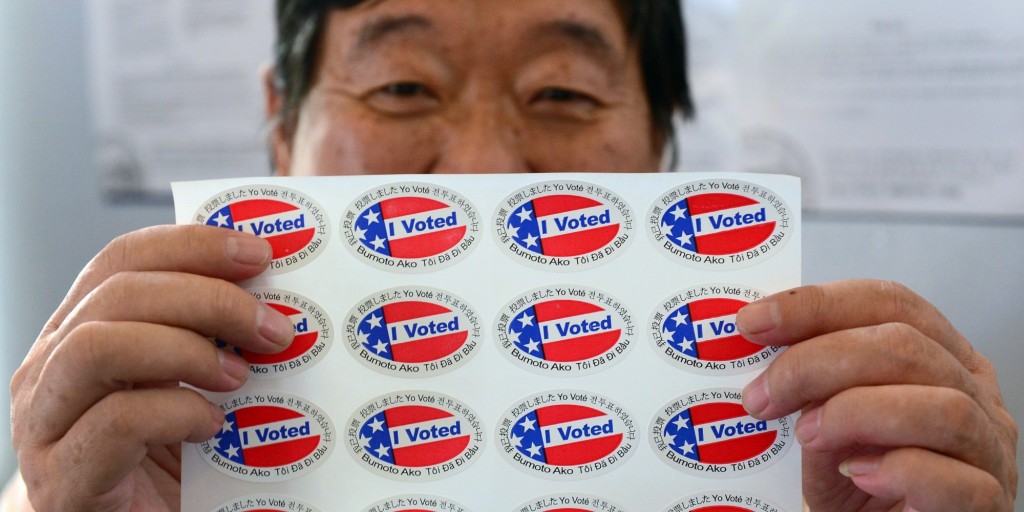By Jennie L. Ilustre
Historically, Asian Pacific Americans have overwhelmingly voted for the Democratic Party. But in the 2014 midterm elections, the door opened a crack: They voted 50-49 in favor of the Republican Party. Although Democratic advocates sniffed that it was just a one-point advantage, Mainstream America took notice. Politico newspaper’s top expert Alex Burns tweeted on election night, “Wow – GOP wins Asian Voters by 1 point Nationwide, 50-49.”
Eleven months before the 2016 presidential elections, the Asian Pacific American vote is up for grabs.

In November 2016, term-limited President Barack Obama will not be in the ballot to insure a big turn-out among the reliable Democratic Party base of solid African American bloc, as well as the Latino bloc and the Asian Pacific American vote.
In the 2012 presidential elections, Asian Pacific American voters overwhelmingly favored Obama, who got 72 per cent of their vote. That’s about 2.5 million out of a total of 3.6 million voters, according to Behind the Numbers,” a survey conducted by the Asian American Justice Center (AAJC), Asian and Pacific Islander American Vote, and National Asian American Survey.
Pew Research Center reported that 71% of Hispanic Americans voted to re-elect Obama. Republican Party’s Mitt Romney, who famously suggested “self-deportation” as a solution to the nation’s 11 million undocumented, mostly Latinos, got 27% of their vote. Media reported that nine in ten (93%) of African Americans voted for Obama. (Romney won 72 percent of the white vote.)
RNC’s Strategy
In next year’s presidential elections, the Republican Party is determined to capture a big chunk of the Asian Pacific American electorate, by using a winning 2013 data-driven and neighborhood-based field program. Last August, the Republican National Committee (RNC) launched the Republican Leadership Initiative. The six-week program for Asian Pacific American volunteers focused on field organizing skills, and also voter registration and voter engagement in all 50 states. The Initiative is part of the GOP strategy in achieving its 2016 goal: Win back the White House.
RNC is methodically expanding its Republican Leadership Initiative. Last month, Politico reported that RNC kicked off the Republican Leadership Initiative GOPVets program. The mission: Voter registration of national military and veterans and their families, and turn-out of 700,000 new voters from those communities on Election Day on November 8, 2016.
Remarked RNC Chairman Reince Priebus, in noting the Republican rout of Democrats in the 2014 congressional and local elections: “We are the only entity, Democrat or Republican, currently organizing efforts on this scale in states across the country as we build the largest infrastructure in our party’s history to take back the White House…Our party heads into the 2016 election with positive momentum and with the right vision to put our country back on track.”
APA Voter Power
The Republican Leadership Initiative builds on the party’s highly-successful campaign model two years ago. “Ever since 2013,” RNC Asian Pacific American Press Secretary Ninio Fetalvo said in an email, “we’ve been building relationships with the communities through our candidates. When they actively engage and build strong relationships with the community, Asian Americans come out to vote.” The all-out grassroots efforts in 2013 led to a Republican Party wave in the 2014 midterm elections.
Fetalvo pointed out that last August, the RNC also unveiled “a new ad aimed at recruiting Asian Americans for our Republican Leadership Initiative program.” The YouTube advertisement targeted the Millennials, people born between 1982 and 2000. The Millennials are also called Generation Y, following Generation X. A 2014 Asian American and Pacific Islander Vote survey showed that nearly three in ten (27%) of the Millennials are “undecided,” and their vote is up for grabs.
Gautam Dutta, executive director of the Asian American Action Fund, a Democratic political action committee, expressed determination in fighting for the 2016 vote. “No party can afford to take Asian Americans and Pacific Islanders for granted,” he stressed in a December 2 email. While GOP candidates like (Donald) Trump, (Ben) Carson, and (Jeb) Bush try to divide and conquer, Democratic candidates like Hillary Clinton and Bernie Sanders embrace America’s diversity of cultures, religions, and people. We look forward to earning every voter’s vote in 2016.”
Two facts stand out in explaining why the Asian Pacific American vote is crucial in the 2016 presidential elections. A 2014 Asian American and Pacific Islander Vote survey shows that almost half of Asian Pacific American voters do not identify with either party, and are therefore up for grabs in next November’s presidential elections.
A similar 2012 survey had the same conclusion: “Asian Americans and Pacific Islanders do not strongly identify with any party. They vote for candidates who support and promote progress on issues that matter to their families and communities…only 53 percent of Asian Americans identified with either major party (with similar findings for Pacific Islanders).”
Increasingly, Asian American voters are a factor in presidential battleground states, including Florida and Virginia, which also grew in population faster than the national average. Congressman Mike Honda (D, CA) told CNN in 2012: “We used to be marginalized politically, but now people are understanding we’re the margin of victory.”
When Asian American advocates forge a coalition among its diverse communities for a common goal, they make a big difference. In 2006, former U.S. Navy Secretary Jim Webb defeated popular Senator George Allen (R, VA), in part because of his record as a Vietnam War combat veteran. Advocates noted that his margin of victory was due to the Asian American vote. Webb’s wife is a Vietnamese American lawyer, who credits the U.S. for educational opportunities afforded her as a refugee. Webb, who recently dropped out of the Democratic presidential primary, is considering running as an Independent.
GOP ‘Gets’ the Message
“Only one national Asian American organization has preached and pushed for an Asian American bloc vote, since its establishment in 1998. It is the 80-20 PAC,” declared S.B. Woo, former Delaware lieutenant governor and the force behind the non-partisan political action committee (PAC), whose goal is to achieve a margin of victory of 80/20 in favor of its endorsed presidential candidate.
“The increasingly larger bloc vote for the Democratic presidential candidate is due mostly to 80-20s endorsement,” he stressed in his November email. “Before 80-20’s establishment and first endorsement, the majority of Asian Americans voted Republican. Immediately thereafter, increasing majorities of Asian Americans voted Democrat.”
“However, 80-20 doesn’t identify with the Democratic Party like the other minorities,” he stressed. “80-20 has consistently advocated a swing bloc vote in order to induce the two political parties to compete to serve Asian Americans’ rightful interests. The Republican Party may finally have gotten 80-20’s message this year.”
 Asian Fortune Your source for all things Asian American
Asian Fortune Your source for all things Asian American



